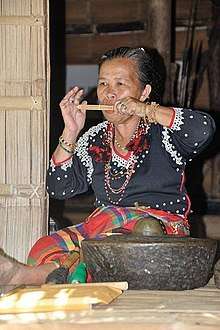Blaan people
 | |
| Total population | |
|---|---|
| Unknown | |
| Regions with significant populations | |
|
Soccsksargen, Davao | |
| Languages | |
| Blaan, Cebuano, Filipino, English | |
| Related ethnic groups | |
| Lumad, Bajau, Moro, Visayans, Filipinos, and Austronesians |


The Blaan people,[1] alternatively spelled as "B'laan",[2] are one of the indigenous peoples of Southern Mindanao in the Philippines. Their name could have derived from "bla" meaning "opponent" and the suffix "an" meaning "people". Other terms used to refer to this group are Blaan, Bira-an, Baraan, Vilanes, and Bilanes.
Indigenous Blaan religion
Some of the deities in the Blaan pantheon include:
- Melu – The Supreme Being and creator. He has white skin and gold teeth. He is assisted by Fiuwe and Tasu Weh.
- Sawe - Joined Melu to live in the world
- Fiuwe – A spirit who lived in the sky.
- Diwata - A spirit who joined Fiuwe to live in the sky
- Tasu Weh – The evil spirit.
- Fon Kayoo – The spirit of the trees.
- Fon Eel – The spirit of water.
- Fon Batoo – The spirit of rocks and stones.
- Tau Dalom Tala - The spirit who lives in the underworld
- Loos Klagan – The most feared deity, uttering his name is considered a curse.
Relation to other groups
The Blaan are neighbors of the Tboli, and live in Lake Sebu and Tboli municipalities of South Cotabato, Sarangani, General Santos City, the southeastern part of Davao and around Lake Buluan in North Cotabato. They are famous for their brassworks, beadwork and tabih weave. The people of these tribes wear colorful embroidered native costumes and beadwork accessories. The women of these tribes, particularly, wear heavy brass belts with brass 'tassels' ending in tiny brass bells that herald their approach even when they are a long way off.
Displacement
Some Blaan natives were displaced when General Santos City was founded in 1939. Others settled in the city.
Their language is said to be the source of the name for Koronadal City, from two Blaan words – kalon meaning cogon grass and nadal or datal meaning plain, which aptly described the place to the natives. On the other hand, Marbel, which is another name for the poblacion, is a Blaan term Malb-el which means "murky waters" referring to a river, now called Marbel River.
The tribe practices indigenous rituals while adapting to the way of life of modern Filipinos.[3]
Recent developments
The tribe received some press when they gave Filipino boxer Manny Pacquiao a tribal rank.[4] However, relations with settlers and their descendants isn't always harmonious; Ilonggo settlers reportedly clashed with some Blaan natives in March 2015.[5]
External links
References
- ↑ http://www.rappler.com/nation/94006-proud-blaan-women
- ↑ http://www.ethnicgroupsphilippines.com/people/ethnic-groups-in-the-philippines/blaan-sarangani/
- ↑ Blaan women record dreams in woven mats – INQUIRER.net, Philippine News for Filipinos Archived 2009-08-04 at the Wayback Machine.
- ↑ "Blaan tribe names Pacquiao ‘Datu’"
- ↑ http://www.tempo.com.ph/2015/03/12/moro-ilonggo-settlers-clash/